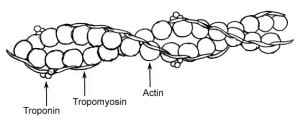A reader to this blog posted this excellent question:
Hi. My kids heard about this “trick,” one which I assume has to do with muscles or musculo-skeletal mechanics (or crampinG) but for which I don’t really have a definite, or detailed explanation. If you extends your arms out, holding your fists side by side together as hard as possible for 30 seconds, when you try to pull them apart it feels as if they are stuck or magnetized together. What is a detailed explanation for that biological mechanics trick?
This is similar to when you stand in a doorway and push your arms against the door frame really hard for 30 seconds, and then your arms seem to float up on their own when you let go. However, this seemed really counterintuitive to me, because I would expect your perception to be the *opposite* of what your muscular effort was. For instance, in visual perception, if you stare at a blue dot, then you get a yellow afterimage because you saturate your blue receptors and so the opposite color comes out stronger. With muscles, I would expect that if I push my hands together, then when I let go it would feel as if they’re pulling away, because I’ve fatigued my “pushing” muscles. But that’s not the case.
So, I had to go to the experts. I got this great explanation back from Patrick, a biology teacher in California:
This happens because of how muscle cells actually cause contraction. There are proteins called myosin and actin arranged inside the cells with little “cross bridges” that reach out from the myosin filaments to grab and pull the actin filaments, sliding them over the myosin. They are arranged in multiple small clusters called sarcomeres. Each sarcomere is shortened by this pulling action, their collective shortening causing the “contraction” that we are familiar with. This action requires energy, but interestingly enough, the ATP energy molecule comes in at the end of a cross bridge’s action. The addition of the ATP molecule allows the cross bridge to release the actin so it can grab further along (kind of like a kid on the monkey bars). There’s other stuff involved (Calcium from the Sarcoplasmic Reticulum), but when you’ve been exerting your muscles as hard as you can for 30 seconds, you temporarily exhaust the ATP levels in those muscles. When your brain stop sending signals to those muscles, they stop actively contracting, but because of the lack of ATP, the myosin can’t release the Actin. When you try to separate your arms, using OTHER muscles, the first ones haven’t relaxed yet. Since you KNOW you aren’t contracting those first muscles (since you aren’t sending signals to do so), your brain interprets this as some external force, etc. Once those fatigued muscles have recovered their ATP, they’ll be fully relaxed.
This is the same effect in play that causes rigor mortis, the stiffening of a corpse as the individual cells run out of ATP and the myosin cross bridges start to get locked on to actin filaments.
 If you’re an educator (or anyone) and would like a poster that includes a great illustration of the actin/myosin, sarcomere, ATP, and ratcheting action as described by Patrick. The poster and classroom supplemental material are part of the Exploratorium’s digital library learning collection. You can download a PDF of the poster here.
If you’re an educator (or anyone) and would like a poster that includes a great illustration of the actin/myosin, sarcomere, ATP, and ratcheting action as described by Patrick. The poster and classroom supplemental material are part of the Exploratorium’s digital library learning collection. You can download a PDF of the poster here.
You can download the Exploratorium Muscle Poster Activity Guide (including dissecting a muscle, and other muscle-related activities).
